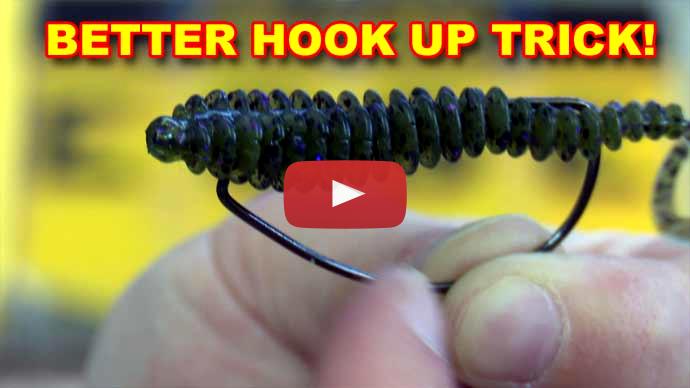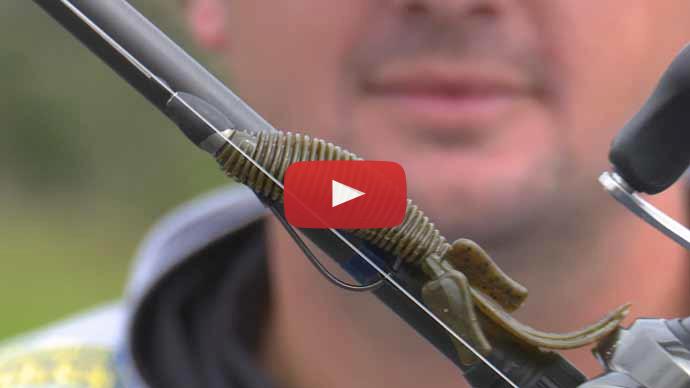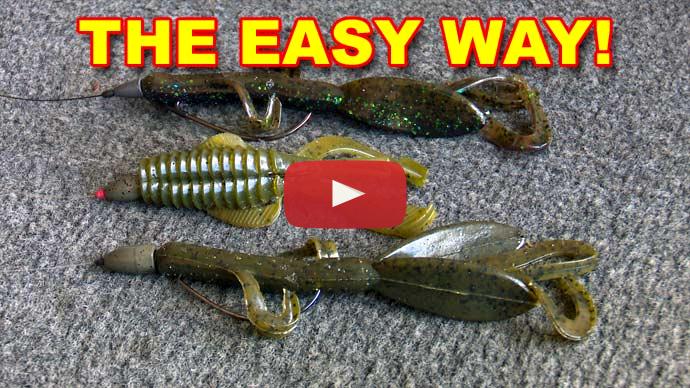You know, Texas rig baits have been in the bass fisherman's arsenal for decades now, and for a good reason, they catch fish. But they can also be some of the most challenging baits to fish as well. I mean, it can be difficult to detect a bite, and sometimes the fish just come unbuttoned before you can get them back to you. A lot of that has to do with the equipment you're using. So today let's talk about building the ultimate Texas rig setup, from the bait casting reel to the bait. Let's look at every component so that they all work together in concert to help you catch every bass that bites. So let's start with the baitcasting reel.
First thing out of the gate is the baitcasting reel should have a fast gear ratio. We're talking 7.1 to 7.5 to 1 gear ratio. Now that's not because you're working the bait fast, you actually work the bait with your rod tip and you move it slowly. But once you have that bait out of the strike zone, you wanna reel it back up as quickly as possible and fire that bait back out there. That's because first of all, you don't work the bait all the way back to you, but you wanna keep the bait in the strike zone as much as possible. The longer you have, and the more often you have the bait in the strike zone, the more bites you're going to get. So that's number one. Number two, while you're fishing a Texas rig bait and it's falling slowly through the water column, usually on the initial cast, that's a lot of times when the bite occurs. So there's a lot of slackline, you need to reel that up quick before you set the hook. So a fast gear ratio enables you to do that.
And a couple times also, every once in a while it'll happen but a bass will pick up that bait and it'll come right at you, right towards you. You need to catch up to them before you can set the hook. So again, a fast-speed gear ratio really enables you to do that. The other component to pay attention to is the drag, particularly the pound of drag, how many pounds of drag is on that reel? I like a reel that has at least 14 pounds of drag, if not higher. I like to crank it down all the way so you can get that hook set. Typically, you're using baits that have a strong hook, a single hook. So you need to get that into the jaw of the fish and get them away from the cover you're fishing, then you can release the drag.
For me, I have a pretty good hook set, and if I have a drag that's less than 14 pounds, I'll feel it slip and I won't get a very good hook set. And a lot of times that's how guys lose fish, is that you'll feel that drag slip when you set the hook. You gotta tighten it down more, and then you can back off on it when you're fighting the fish. So a strong drag, fast gear ratio. Let's move on to the rod. The rod, now let's be really clear here, I'm not talking about just flipping and pitching when you're using Texas rig baits. That's a specific technique, specific gear for that design just for that. So we're talking more about general-purpose Texas rig fishing, and a longer rod is necessary for that.
A 7-foot-4 to 7-foot-8 is kind of the ideal area, maybe 7-foot-3 even if you're a shorter guy, because of several reasons. One of it, you're gonna...you get longer casts out of that with a longer rod. And sometimes you're just fan casting a flat or a grass bed or something like that, and you just need distance, and a longer rod will enable you to have that. But also a longer rod gives you that leverage to pull up some of that slack line that I just talked about and also set the hook, which is why you want a medium heavy or even a heavy power rod. Medium heavy is usually sufficient enough to get that backbone to set the hook, and when you're fighting the fish back, you keep them under control. A longer rod with a medium heavy backbone enables you to do that, keep that fish pinned.
Paired with that is a fast action rod tip. That gives you several things. First of all, it helps with casting efficiency, casting accuracy, smoother casting, and it also gives you that sensitivity to help you pick up on some of those lighter bites and feel those. So it's a fast action rod, fast action tip is necessary. I would go with graphite or a graphite carbon fiber composite, something like that, not fiberglass. Fiberglass rods, number one, they're heavier and you're gonna be fishing, you know, at an angle, 9:00, 10:00 angle all the time holding that rod up. And a heavier rod just gets, wears on you over the course of a day of fishing. But also, fiberglass is not as sensitive enough that you need for Texas rig fishing. Graphite or graphite composite rod is more sensitive. So that's what we need for a rod. Also paired with it, just make sure you're using quality components on the rod, alkaline, zirconium guides, titanium guides, that sort of thing.
Same thing with a graphite, reel seat. The handles are up to you, personal preference cork, foam, whatever you want.
Moving to the line, I have a real strong preference here, and that is fluorocarbon line is...that is better for all purpose Texas rig fishing. And the reason why, is a lot of people think braid is actually multipurpose. It isn't. The braids in particular is actually less abrasion resistant than fluorocarbon. And that really comes into play when you're throwing around rocks, boulders, riprap, or a lot of stumps, things like that where the line can get freight or nicked. Braid actually will get freight or nicked more often than fluorocarbon. In addition, fluorocarbon is less visibility in the water than braid.
Now, some may argue, "Oh, we got thin diameter braid." You have thin diameter fluorocarbon too, often very close to the same pound test. And side by side that fluorocarbon is gonna have less visibility in the water. When you're moving a real slow-moving bait, that can be the difference between getting bites and not. Plus, fluorocarbon has a little bit of giving it, a little bit of stretch, and you need that when you are fighting the fish back. You got a single hook in there and that fish surges, especially the bigger fish, you need a little bit of give to keep that fish pinned. So fluorocarbon works in your favor for that. Now, I know it's expensive, and a lot of guys like to use braid to fluorocarbon leader to save on expenses. Here's the thing guys, it's fine to use braid for backing, just as long as that knot is still in the reel on your longest cast, then you're fine.
The problem is when you have that knot out there between you and the bait or you and the fish and you set that hook. I've seen a lot of guys lose a fish, lose their lures a long...you know, yards of fluorocarbon line because that knot fails. It happens, and that's because of that hook set, all the stress gets put on that single point of failure. So make sure that knot is buried in your reel, and you can use braid backing to save a few bucks instead of spooling the entire reel full of fluorocarbon line. Fluorocarbon, I'll use 15 to 17 pound fluorocarbon line. I like InvizX, I like Sniper line, both of those work really well. I'm pretty happy with both of them, particularly Seaguard InvizX. Moving on, now, let's move on down the line. We're gonna get to the weight.
That is a critical component, some people overlook that. The weights, there's a couple things to take into consideration. First of all, the type of lure you're throwing, if you're throwing the plastic worm. A ribbon tail worm, it's been around since the '70s, I've been throwing them since they first came out. The thing about them is they're very slender, very thin profile in the water. So, they don't have a lot of water resistance in them. So, a 3/8 ounce weight is too much. Maybe a 3/16 would be a better choice or a 1/4 ounce. You put a 3/8 ounce weight on that and it's gonna boom, just shoot through the water really quick. And you want a slow fall with Texas rig baits, the slower the fall gives more chance for that bait to get bit. So typically, you don't want to fast drop.
So a 3/16 ounce is really something that works better with those slender profile baits. Conversely, when you're throwing a larger bait with a lot of appendages on it that displaces a lot of water, a 3/8 ounce weight works better for that, or maybe even a 1/2 ounce. It'll still have that same slow fall, but you need a little bit heavier weight, not only to make its fall, but you gotta get those appendages to work. If you're using a 3/16 ounce weight, it may fall so slow that it looks like a dead piece of plastic and those appendages aren't flapping. So, you have to up the weight a little bit when you're upping the size and adding more appendages to your plastic bait.
Something else to take into consideration is where they're actually, where you're fishing in. If you're throwing in weeds and heavy cover, a little bit heavier weight is necessary to pull that bait down through the cover, as opposed to if you're fishing in open water, let's say you're fishing deeper water, deeper structure, humps, ridges, ledges, creek channels, where there's not a whole lot of cover down there, you don't need such a heavy weight to punch through all that vegetation.
So just, those are the things you need to take consideration as to what size, weight to use. I think a 3/8 ounce is a good starting point and then you upsize or downsize from there depending on those variables. What's really important though, is that you use tungsten. Tungsten weight makes a big difference here with Texas rig fishing because it is more sensitive, that's a primary reason. Tungsten is a denser weight, and so it transmits those light bites a lot better up through the line than lead. Lead just kind of deadens the feel, really. Lead also really frustrates me, is when you're fishing for a course of a day or several days and you use that same lead bullet sinker, it gets banged up and up towards the top where the line enters in through the nose can bend, you can pinch, and it can actually damage the line right there.
So, tungsten is the way to go on that. Plus, think about it, guys, more and more states are banning lead every year for fishing and for shooting and other things. It just makes sense to move to tungsten. I slowly moved to tungsten. I started off with some of the more common weights that I use and then branched out from there over the course of several years, because tungsten is expensive. My wallet can't afford to buy, to switch over all tungsten all at once. So I encourage you to slowly start moving that direction. So when your state bans lead, you're that much further in the game. You don't have to fork out a chunk of money to switch all over to tungsten all at one time. Just something to think about. Let's move on down towards the hook.
Typically, if you're fishing a bait that's less than six inches long, you're using a 3/0 hook. And if it's larger than six inches, you're using a 4/0. That varies. If you're using a really thick-bodied lure, then you may need to use a 4/0 right out of the gate, regardless of how long it is. So, the body of it, you wanna make sure there's enough bite in there. So when you set the hook, and if hook comes out, if you got a small bite hook and it can't get that hook all the way out because the body's thick, then you don't get a good hook set on the fish. This is why I like to use EWG, extra wide gap hooks, they tend to have a better bite. I've been using those. The original problem way back in the, you know, before the mid '80s when EWGs came out, you had a J shaped hook and you'd use that for Texas rigging.
Well, the point, you know, here's the bait. Well, the point would come up like this, and after you've set the hook a few times or if you've gone through enough brush, the hook starts coming out real easy out of that bait. And then it wants to pick up everything, every little blade of grass, every weed, or even get hung up on a stick or branch as you're working it through wood, it just got hung up an awful lot. So you try to Texpose it where you take the point and you kind of bury it back into the bait. Well, with a J hook, you kinda get this hump now to try to get that hook point in there. It looks weird, it starts to fall spiral odd, and it still keeps popping out. So when the EWGs came along, where the hook is flat with the bait, works great.
Now you can skim the hook and voila, it is weightless, works beautifully. And I caught a lot more fish that way instead of a lot of gunk. Some guys don't like them because the hook point is in alignment with the eye, and they feel that the eye interferes with that hook point and causes them to lose fish. Personally, I've never had that issue. However, if it gives you more confidence, you can use an offset EWG hook and that way the hook point is above the eye. I don't like them because now you're introducing the problems that the EWG solved. Again, that hook point is sticking up above, your bait's crooked, trying to get it skin hooked. It works for a while and pretty soon it won't skin hook anymore. Now you get exposed hook, and it just likes to pick up all the gunk and the weeds and get hung up in wood and whatnot.
And I have more problems with an offset EWG. But if you're fishing open cover, you're fishing deep structure where it's just rocks, things like that, that's not a problem. So, an offset EWG works just fine. There's no right or wrong here. Whatever works best for you, knock yourself out. Let's talk about the bait. Finally, we're getting to the bait. Bait selection is...boy, you've got a wide variety of plastics you can use. Now, there's the ribbon tail worm I mentioned earlier. They've been around for decades, and for good reason. Fish just don't get used to them. They just...these baits keep working over and over. I've been throwing Texas rig ribbon tail worms since they first came out and I still do today, and they catch just as many fish today as they did back then. Aside from that, there's a plethora of options available to you. So how do you decide which one to use for when?
I kind of go by this, I like to look at the activity level and the aggressive nature of the bass at that day. If they are aggressively feeding and they are very active, then I'll use a larger bait that has a lot of movement and appendages on it, or large appendages like a gator tail worm, something that displaces the water and puts out a lot of vibration. I'll use those on those days. On the other end of the spectrum, when the bass are inactive, they're not feeding very much. Typically after a big front moves through or maybe it's cold, muddy water, in a situation like that, then I'll go the opposite direction. I'll downsize smaller lures with very little action. We're talking tubes, finesse worms, leeches, reapers, those type of things, that's what I'll use. And then you got the whole spectrum in between. So what we're trying to do here is match the activity level and aggressive nature and feeding level of the bass.
So you may have to experiment a little bit to match that up when you first get out there fishing. But the fish will tell you, if you're not getting bites at all, then you're way off base. But if you're getting follows or you're getting a few bites here and there, you're close, and just adjust as necessary. And trust me, you can hone in on exactly what the fish want very quickly, especially with the first bite that you get. That fish is going to tell on all of them and say, "Hey, this is...now you nailed it, this is what we want today on the menu." So, with that in mind, that's gonna enable you to create the ultimate Texas rig setup. Hope that helps. For more tips and tricks like this, visit Bassresource.com.



